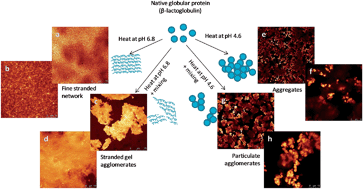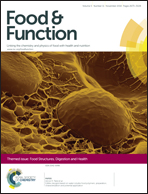Influence of heat and shear induced protein aggregation on the in vitro digestion rate of whey proteins
Abstract
Protein intake is essential for growth and repair of body cells, the normal functioning of muscles, and health related immune functions. Most food proteins are consumed after undergoing various degrees of processing. Changes in protein structure and assembly as a result of processing impact the digestibility of proteins. Research in understanding to what extent the protein structure impacts the rate of proteolysis under human physiological conditions has gained considerable interest. In this work, four whey protein gels were prepared using heat processing at two different pH values, 6.8 and 4.6, with and without applied shear. The gels showed different protein network microstructures due to heat induced unfolding (at pH 6.8) or lack of unfolding, thus resulting in fine stranded protein networks. When shear was applied during heating, particulate protein networks were formed. The differences in the gel microstructures resulted in considerable differences in their rheological properties. An in vitro gastric and intestinal model was used to investigate the resulting effects of these different gel structures on whey protein digestion. In addition, the rate of digestion was monitored by taking samples at various time points throughout the in vitro digestion process. The peptides in the digesta were profiled using SDS-polyacrylamide gel electrophoresis, reversed-phase-HPLC and LC-MS. Under simulated gastric conditions, whey proteins in structured gels were hydrolysed faster than native proteins in solution. The rate of peptides released during in vitro digestion differed depending on the structure of the gels and extent of protein aggregation. The outcomes of this work highlighted that changes in the network structure of the protein can influence the rate and pattern of its proteolysis under gastrointestinal conditions. Such knowledge could assist the food industry in designing novel food formulations to control the digestion kinetics and the release of biologically active peptides for desired health outcome.

- This article is part of the themed collection: Food Structures, Digestion and Health International Conference

 Please wait while we load your content...
Please wait while we load your content...